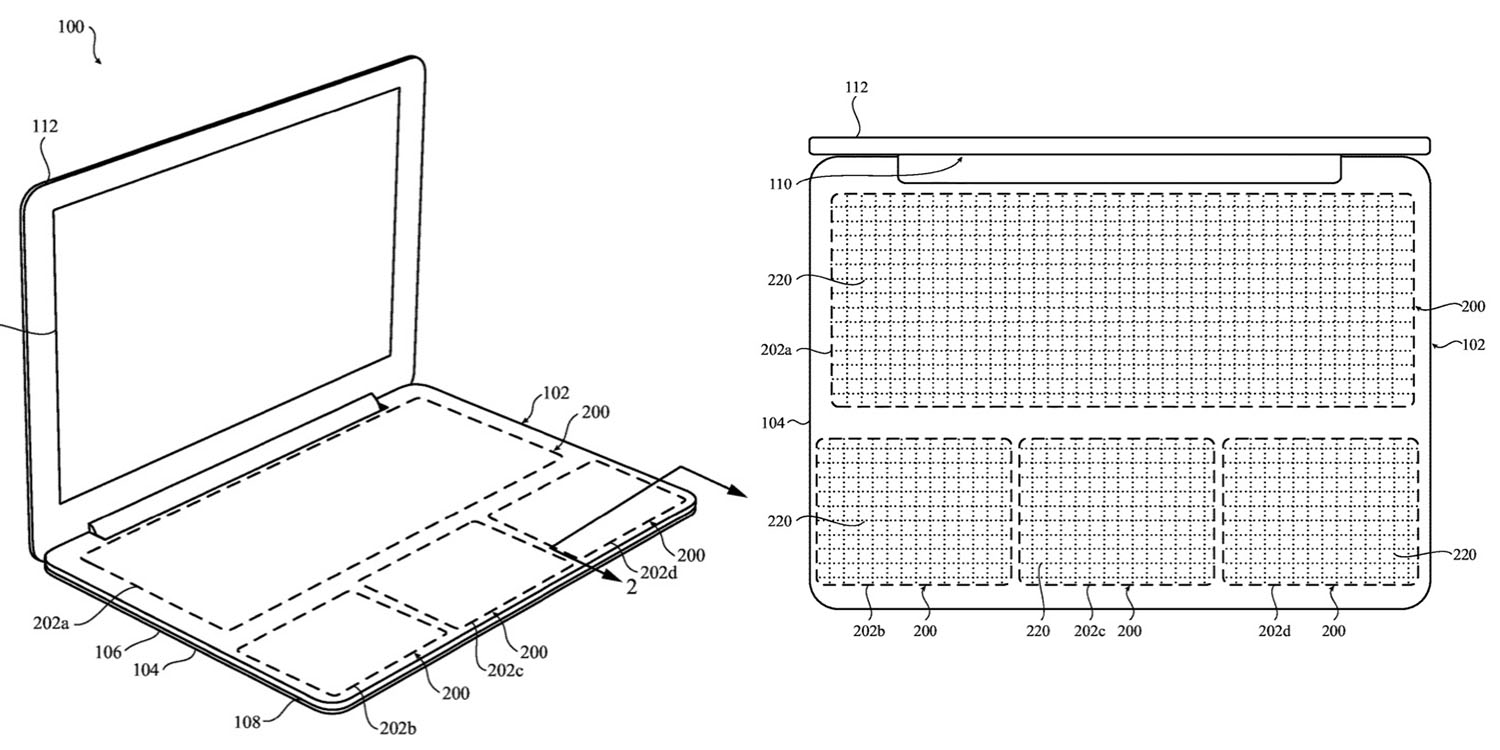
An Apple patent granted today describes a MacBook with a solid-state keyboard using an all-touch surface which can be reconfigured as the user desires.
A user working with numbers might opt for a large numeric keyboard, for example, while an artist might instead choose a large area for drawing …
Background
There is plenty of patent evidence to suggest that Apple’s long-term goal with MacBooks is to replace mechanical keyboards with touch-sensitive surfaces.
There are, of course, lots of barriers to this. An iPad-style keyboard doesn’t permit touch-typing, and extended typing on a glass keyboard is uncomfortable. But Apple does have patents designed to address these issues.
Apple proposes a three-fold approach to making a screen-based keyboard feel like a physical one. First, allowing a flexible screen to deform when a virtual key is pressed. Second, haptic feedback would be used to simulate the click of a real key. Third, an electrostatic charge could also be used to simulate the feeling of the edge of a key, making it feel like a real keyboard when you place your fingers on it ready to type.
The company made its first step in this direction, back in 2015 when it replaced a moving trackpad surface with a Force Touch one, where the clicks are simulated.
Today’s solid-state keyboard patent
While there are significant challenges in making a virtual keyboard feel real, Apple’s patent argues that there are equally substantial benefits.
First, it says, mechanical keyboards are prone to failure, including from debris trapped within them. This was, of course, a major problem with Apple’s butterfly keyboard design, which forced the company to offer out-of-warranty repairs and to subsequently abandon the design.
Conventional input devices, such as keyboards or track pads for a laptop, are susceptible to damage. For example, debris and other contaminants may enter the casing of the electronic device through the keycap apertures and may subsequently damage the internal components of the electronic device. The damage to the internal components may render the electronic device inoperable. Likewise, the mechanical structures forming the input devices may be especially vulnerable to a drop or mechanical shock.
Second, a solid-state approach offers the ability to tailor the keyboard and trackpad layout to whatever the user is doing at any given time. In some cases, opening a particular app may automatically reconfigure the input devices.
The configurable, force-sensitive input structure may be configured as a variety of input devices for the electronic device including, but not limited to, a keyboard, a number pad or a track pad. The electronic device may utilize a single input structure for forming a number of distinct input devices, or, conversely, may include a number of input structures for forming distinct input devices […]
Positioning of the input devices of the force-sensitive input structure may be customizable. That is, the input devices can be moved to distinct locations on the casing, within the force-sensitive input structure. As a result, the input devices can be moved to a specific location of the casing based on user preference. Similarly, one or more of such input devices may be resized or reshaped by user input, operation of an associated electronic device, software, firmware, other hardware, and so on. Thus, the input structure may be said to be dimensionally configurable insofar as input devices (or regions) on its surface may be moved and/or resized and/or reshaped.
Configurable inputs could also allow things like symbol or emoji keyboards.
By comparison to a conventional a laptop which may only include a standard “QWERTY” keyboard and a track pad, electronic device having force-sensitive input structure can include a QWERTY keyboard, a track pad, a standalone numeric keypad, a special characters or glyph keypad, and/or enlarged directional keys portion.
While many of us are extremely wary of the idea of replacing a proper moving keyboard, and would prefer to see moving keycaps with dynamically-assigned functions, Apple does acknowledge that it may need to adopt a hybrid approach with actual deformable areas.
The electronic device may include a contact portion formed from a flexible (or partially-flexible) material that may bend or deform into and/or to contact a portion of an input stack-up. For example, the contact portion may be a metal sheet or part of a metal housing of an electronic device. The input stack-up may capacitively sense the deformation of the contact portion due to application of an input force on a corresponding contact portion of the electronic device.
Apple doesn’t expect to get there anytime soon, and in the meantime continues to address ways to make proper moving keyboards thinner – another prospect which makes many of us nervous …
Via Patently Apple
FTC: We use income earning auto affiliate links. More.



Comments